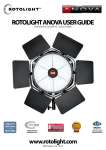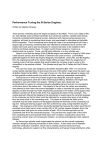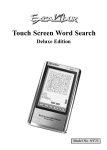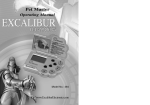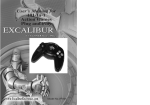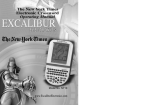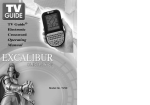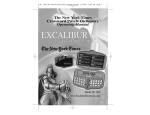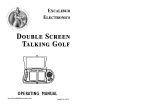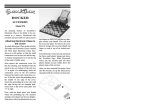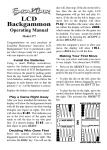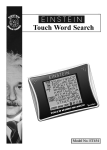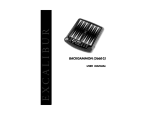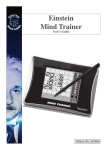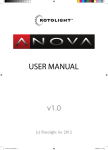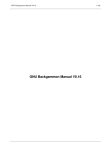Download Excalibur electronic E125 User's Manual
Transcript
Backgammon Wizard Model No. E125 C ongratulations on your purchase of Einstein LCD Backgammon Wizard. Now, the challenging game of Backgammon can travel with you anywhere. Einstein LCD Backgammon Wizard offers varying levels of challenging computer opponents, and has simple, intuitive controls. Albert Einstein is probably best known for his famous formula, E=mc2, but this German-born theoretical physicist made unparalleled contributions to modern scientific thought. In the field of physics, he introduced his special theory and general theory of relativity and, in 1921, his work on the photoelectric effect won him the Nobel Prize in Physics. Einstein enjoyed playing the violin and for much of his life, greatly enjoyed the game of chess. He routinely asked children he met if they liked music or if they could play chess. He would then teach them the basics of the game, and would play that child every time that they met. ABOUT ALBERT EINSTEIN Born: March 14, 1879 Ulm, Württemberg, Germany Notable Awards: Nobel Prize in Physics (1921) Copley Medal (1925) R.A.S Gold Medal (1925) Max Planck Medal (1929) Benjamin Franklin Medal (1935) Died: April 18, 1955 (aged 76) Princeton, New Jersey, USA Residence: Germany, Italy, Switzerland, USA Citizenship: German (1879-1896, 1914-1933) Swiss (1901-1955) American (1940-1955) Honorary Doctorates: Princeton (1921) Oxford (1931) Harvard (1935) Quotes: “Whoever undertakes to set himself up as a judge of Truth and Knowledge is shipwrecked by the laughter of the gods.” “The secret to creativity is knowing how to hide your sources.” “ALBERT EINSTEIN and related rights TM/© of HUJ, used under license. Represented exclusively by Corbis Corp.” Items Included 1 Einstein Backgammon Wizard Unit 1 User’s Manual 2 Install the Batteries Using a small Phillips screwdriver, remove the battery-compartment panel screw on the back of LCD Backgammon. Then remove the panel by pulling gently from the top. Install two fresh, alkaline AAA batteries, making sure to follow the diagram in each battery slot so that the polarity (+ or -) of the batteries is correct. Replace the battery compartment panel. Play a Game Right Away After you have installed the batteries, the display will show the backgammon board with all the pips (pieces) on their starting points or triangles (see figure on right). The LCD will also show SidE. This indicates you are at the first move of the game and ready to roll the dice to see who goes first. If it doesn't display SidE, use a thin object to press RESET. • Press on the SELECT key to choose the pip you want to move. An arrow will point to the pip if it can be legally moved. • To move the pip the number shown on the top die, press the TOP key. • To move the pip the number shown on the bottom die, press the BOTTOM key. Putting a game “on hold” Any time it's your move and you wish to stop playing for awhile, just press the ON/OFF key. LCD Backgammon will switch off and go into a sleep mode. It will remember the last position, including the score, as long as you do not interrupt the power supply-for example, by removing the batteries. To resume play, just press the ON/OFF key. Deciding Who Goes First Press the ROLL key. You will see the dice roll, then stop. If the die on the top is less than the die on the bottom, LCD Backgammon will go first and play it’s move. If the die on the top is larger, you move first so the display will show PLAy. If doubles (the same value dice) are rolled, the display will show dOUb, which means the stakes for the game can be doubled. You may accept the double or decline it by pressing the ACCEPT or decline DECLINE keys. NOTE: If no key has been pressed for a period of time, LCD Backgammon will turn off, saving your game position. Use the ON/OFF key to resume the game. After the computer’s move or after your move, the display will show rOLL, press the ROLL key to roll the dice. Special Messages During the game the following messages may appear on the display: Making Your First Move The way you select and make your move is very simple. You always have WHITE. PASS - This means you or the computer cannot use the dice or remaining die to 3 make a legal move. Press the ROLL key to continue play. the display, and the dice will be rolled. ON/OFF KEY Use this key to turn LCD Backgammon off and on. LCD Backgammon will remember the board position while it is off. rOLL - Press the ROLL key to roll the dice. dOUb - This means the computer wants to double the stakes, because it thinks it is winning. To accept the double, press the ACCEPT key. To decline the double press the DECLINE key, BUT this means LCD Backgammon wins, so the game will end. LEVEL KEY The level may be checked or changed before you roll your dice. Pressing this key will show the current level, for example:LE 8. You can change the level by pressing the + key or the - key. Each press increases or decreases the level by 1. When the display shows the desired level, press the LEVEL key again to resume play. LOSS - Shows that the game is over. The color Icon or will be on for the side that lost. Press any key to continue. Generally, the higher the level you select, the better your LCD Backgammon will play. Level 1 is the weakest, and plays a running game from the start of the game. This means it will tend to first play it pips that are furthest from its home. Level 8 is the strongest and is designed for tournament players. KEY LAYOUT HINT KEY Press this key if you want to a hint from your LCD Backgammon partner. It shows an arrow to the pip it thinks is the best one to move. It shows another arrow pointing to the triangle to which it should be moved. If you must move in from the bar, it will show an arrow to your best entry triangle. Function Keys TOP KEY Press this key to move your pip (piece) the number shown on the top die. BOTTOM KEY Press this key to move your pip (piece) the number shown on the bottom die. UNDO KEY This key lets you take back a move or moves you’ve decided against, BEFORE you have pressed the ROLL key. Pressing the ROLL key enters your move, so the computer can roll the dice for it’s move. SCORE KEY • Before a game begins, press this key to display your score or accumulated winnings. This score can be negative if you have lost more points than you have won. • During the game, press this key to see your pip score. This is the total of all dice ROLL KEY Press this key when rOLL is shown on 4 you need to roll in order to win the game. Press this key a second time to see the computer’s pip score. -DECLINE KEY Press this key to decline a double by LCD Backgammon. Also use it to reduce the level or contrast setting. / KEY (CONTRAST) Press this key to view the current display contrast setting. You increase or decrease the setting by pressing the + or - keys. This allows you to compensate for differences in lighting and battery strength. Press the / key again to resume play. ACCEPT KEY Press this key to accept a double by LCD Backgammon. DOUBLE KEY Press this key if you think you are winning and want to double the stakes. You can only double if no one has the cube, or you have the cube. You have the cube when a WHITE cube and it’s value is shown on the screen. You may only double before you roll the dice for your turn. OPTIONS KEY Pressing the OPTIONS key repeatedly will display all selectable options. To select or change an option, use the +SELECT or the -DECLINE key. A colon (:) will be shown, if the option has been accepted. Rules Of The Game First press of the OPTIONS key - The Objective bE:EP - Sound is on. The objective of the game is to be the first player to move all their 15 pieces around the Board into their home table(refer to the figure on page 3), and then remove them or “bear off” from the Board . See figure below: bE EP - Sound is off. However, the low tone for illegal moves or illegal key presses does not turn off. Second press of the OPTIONS key CU:bE - The doubling cube can be used. CU bE - Cube is off, so no doubling will be permitted. Third press of the OPTIONS key resumes play. Playing the Game NEW KEY You can begin a new game at any time. • Each player moves their pieces according to the numbers shown on the dice. • A player moves the same piece or any two pieces, once for the number on one die. And again for the number on the other die. But you cannot add the total of the two die. • A player must, if possible, play both +SELECT KEY Press this key to select which pip you would like to move. It will only point to pips that can be legally moved. Also use it to increase the level and contrast setting. 5 parts of his roll. • If it is impossible to use both parts of a roll, a player must (if possible) use the higher part. Then the player must “pass”. • If a player is unable to use any part of his roll to move any of his pieces, he must “pass” and it is his opponent’s turn again. • When a player rolls doubles, you can make four moves of the same piece or any combination of pieces you choose. • Each player moves their pieces from his opponent’s inner table to his inner table as shown below: opponents inner home table before you may move any of your other pieces. For example, refer to the figure below: If you have a piece on the BAR and throw 2 and a 4, you cannot re-enter your pieces on point 2 or 4 since they have been closed by your opponent. You would need to “pass”. You can only get off the BAR if you land on points 1,5, and 6. If you land on point 5, your opponent’s piece will be removed to the BAR. How To Bear Off • When all 15 pieces are in a player’s inner home table, the player must remove or “bear off” the pieces from the board. • If a number thrown is higher than any points occupied by the player’s pieces, then you may bear off from the highest points. For Example, if you throw a 6 and a 4, you can bear off from points 5 and 4, because you have no pieces on point 6. see below: The three type of moves shown are: I - clear of any other pieces II - occupied by one or more of his own pieces. III - occupied by any single opponents’s piece (called a blot). You may hit the opponent’s piece and move it to the BAR. • When you have two or more pieces on a point it is called a “closed point”. Your opponent is not permitted to land on it. See the top figure in next column. • If the number thrown corresponds exactly to a point with a players’s piece, the player may bear it off. • If a number thrown is lower than any points occupied by the player’s pieces, then you must move the piece further How To Get In From Bar • If one of your pieces has been placed on the BAR, you must re-enter into your 6 along in your home table. Gammons Hints On Strategy Early in play it is best to leave your back pieces alone, unless you can bring them out on good throws (6-5, 6-6, 4-4, or by hitting a blot). As the game moves on, you should try to make a prime which is six consecutive closed points. Your opponent cannot move over a prime, so you have blocked him in, thus increasing your chances of winning. You should hit your opponent’s men when he leaves blots far from your home table. Enemy blots in your home table are dangerous to hit, since your opponent may re-enter and hit your blot sending you back to the bar and your inner table. As your opponent makes points in his home table you should play more cautiously because it will be more difficult for you to enter a man after being hit. If the loser has not managed to bear off any men but does not have any of his own men in the winner’s inner table or on the bar, then the winner scores 2 points. This situation is called a “Gammon”. If the loser has not managed to bear off any men and also has at least one man on the bar or in the winner’s inner table, then the winner has made a “Backgammon” and his basic score is 3 points. The winner’s basic score is then multiplied by the value of the doubling cube to obtain the actual number of points scored. Doubling Cube Use of the doubling cube can make the game much more exciting. The cube has its faces numbered 2,4,8,16,32 and 64. At the start of the game the cube is “in the middle”, it does not have any effect at that stage. Special Care • Avoid rough handling such as bumping or dropping. • Avoid moisture and extreme temperatures. For best results, use between the temperatures of 39ºF and 100ºF (4ºC and 38ºC). • Clean using only a slightly damp cloth. Do not use cleaners with chemical agents. Before he rolls the dice to make a move, a player may take the cube from “the middle” and offer it to his opponent. If the opponent accepts the doubling cube, it is turned up with the number 2 showing on it. On any of the opponents turns, before he rolls his dice, he may offer the doubling cube to the other player. If the other player accepts it, the face with the 4 is turned up and the cube is held by that player. This can continue to happen until the maximum cube value of 64 is reached. Battery Information • Your LCD Backgammon uses 2 “AAA” batteries. • Do not mix old and new batteries. • Do not mix alkaline & standard or rechargeable batteries. • Install batteries so that the polarity (+ and -) matches the diagrams in the battery compartment. • Use only batteries of the same type and equivalency. • Remove exhausted batteries from the unit. • Do not short circuit battery terminals. Computers can sometimes "lock up" due to static discharge or other electrical disturbances. If this should happen, use a slim, pointed object to press the buton marked “RESET.” Excalibur Electronics reserves the right to make technical changes without notice in the interest of progress. 7 FCC Notice This device complies with Part 15 of the FCC Rules. Operation is subject to the following two conditions: (1) this device may not cause harmful interference, and (2) this device must accept any interference received, including interference that may cause undesired operation. NOTE: This equipment has been tested and found to comply with the limits for a Class B digital device, pursuant to Part 15 of the FCC Rules. These limits are designed to provide reasonable protection against harmful interference in a residential installation. This equipment generates, uses and can radiate radio frequency energy and, if not installed and used in accordance with the instructions, may cause harmful interference to radio communications. However, there is no guarantee that interference will not occur in a particular installation. If this equipment does cause harmful interference to radio or television reception, which can be determined by turning the equipment off and on, the user is encouraged to try to correct the interference by one or more of the following measures: -- Reorient or relocate the receiving antenna. -- Increase the separation between the equipment and receiver. -- Connect the equipment into an outlet on a circuit different from that to which the receiver is connected. -- Consult the dealer or an experienced radio/TV technician for help. Limited 90 Day Warranty EXCALIBUR ELECTRONICS, INC., warrants to the original consumer that its products are free from any electrical or mechanical defects for a period of 90 Days from the date of purchase. If any such defect is discovered within the warranty period, EXCALIBUR ELECTRONICS, INC., will repair or replace the unit free of charge upon receipt of the unit, shipped postage prepaid and insured to the factory address shown at right. The only authorized service center in the United States is: Excalibur Electronics, Inc. 13755 SW 119th Ave Miami, Florida 33186 U.S.A. Phone: 305.477.8080 Fax: 305.477.9516 www.ExcaliburElectronics.com Ship the unit carefully packed, preferably in the original carton, and send it prepaid, and adequately insured. Include a letter, detailing the complaint and including your daytime telephone number, inside the shipping carton. If your warranty has expired and you want an estimated fee for service, write to the above address, specifying the model and the problem. DO NOT SEND YOUR UNIT WITHOUT RECEIVING AN ESTIMATE FOR SERVICING. WE CANNOT STORE YOUR UNIT! The warranty covers normal consumer use and does not cover damage that occurs in shipment or failure that results from alterations, accident, misuse, abuse, neglect, wear and tear, inadequate maintenance, commercial use, or unreasonable use of the unit. Removal of the top panel voids all warranties. This warranty does not cover cost of repairs made or attempted outside of the factory. Any applicable implied warranties, including warranties of merchantability and fitness, are hereby limited to 90 Days from the date of purchase. Consequential or incidental damages resulting from a breach of any applicable express or implied warranties are hereby excluded. Some states do not allow limitations on the duration of implied warranties and do not allow exclusion of incidental or consequential damages, so the above limitations and exclusions in these instances may not apply. E125-072908-00 8








